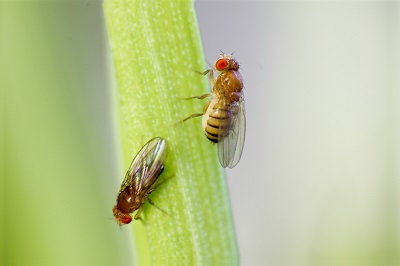By Stephen X. Zhang
The drives to eat, drink, and sleep are with us from birth until death. The motivation to mate stands apart in that it emerges later in life. This is true in many animals, including flies. Where does mating drive come from? Is it generated by new wiring, or was it there all along, lying dormant? While neuroscience has long assumed the former, we find evidence for the latter.

Two fruit flies sitting on a blade of grass.
We initially saw that mating-drive circuitry is wired up and functional in juvenile male flies, but we couldn’t detect the electrical activity that runs through it in adult animals. We stimulated the motivational neurons and found that even the youngest males started chasing around females and singing the courtship song to them. That means the circuitry is functional in juveniles — it’s just inactive.
If we compare mating-drive circuitry to a highway, in a mature male fly, the highway is busy and full of activity. In a juvenile male fly, the highway is built and functional, but the traffic is stopped.
As in mammals, we found that the transition to sexuality in flies is under hormonal control. In this case, mating drive is suppressed by a hormone named juvenile hormone, whose titer decays away over days. By manipulating the receptors for the hormone we found that it impacts the parts of courtship circuitry that convey the motivational drive; as far as we can tell, the sensory and motor centers are unaffected. The young flies can perform courtship, but they lack the motivation.
In the highway analogy, juvenile hormone would function as the red lights that stop traffic from flowing through the motivational highway. As the animals age, the traffic lights begin to turn green, gradually allowing activity to flow through. The decline of the hormone therefore awakens the mating drive of a fly.
Stephen Zhang conducted this work as a graduate student in the labs of Mike Crickmore (Kirby Center, Boston Children’s Hospital) and Dragana Rogulja (Department of Neurobiology, Harvard Medical School). He is currently a postdoctoral fellow in Mark Andermann’s lab at Beth Israel Deaconess Medical Center.
Learn more in the original research article:
Hormonal control of motivational circuitry orchestrates the transition to sexuality in Drosophila. Zhang SX, Glantz EH, Miner LE, Rogulja D, Crickmore MA. Sci Adv. 2021 Jun 16;7(25):eabg6926. doi: 10.1126/sciadv.abg6926. PMID: 34134981; PMCID: PMC8208730.
Also check out this June 24th Science Podcast interview of Stephen Zhang (starting around 11 minute mark).
News Types: Community Stories
